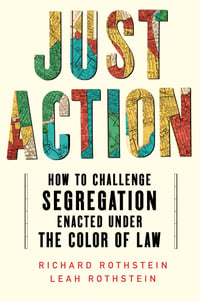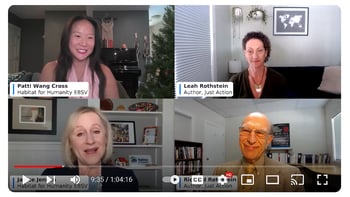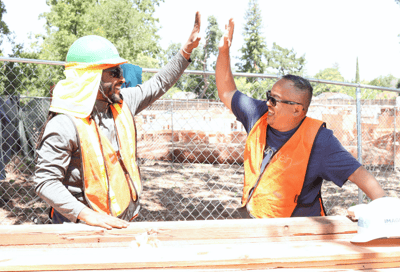Happy Fair Housing Month! April marks the anniversary of the Fair Housing Act, passed 56 years ago this month. It's not merely a time to celebrate, however; it's an invitation to reflect on the legacy of housing discrimination, and recommit to undoing its wrongs and preventing future harm. This year's theme is "Fair Housing: The Act in Action," and to that end, we have a list of four ways you can do something concrete about fair housing this month (and every month!).
Last year, we published an educational series to take a closer look at fair housing history here in the East Bay and Silicon Valley. This year, we turn forward and consider what we can do, today, to advance fair housing.
Four ways you can act for fair housing
1. Build new relationships

In their book Just Action, Richard and Leah Rothstein emphasize the importance of building cross-race relationships when it comes to organizing for housing justice. Due to housing segregation, however, many of us don't form those relationships organically in our daily lives outside of work. Our neighborhoods, our civic organizations, our faith communities – these are often largely filled with people who look like ourselves. So, it will likely require some intention and action to build new relationships.
Just Action offers plenty of examples of community members doing just that. In Chicago, artist and photographer Tonika Johnson used the starkly segregated geography of the city to photograph "map twins" – neighbors from the mostly-Black Englewood neighborhood on the South Side, paired with neighbors with a corresponding address on the mostly-White North Side. Out of this project were born friendships, plant exchanges, community events, block clean-ups, and more. [1]
In Winston-Salem, pastors in separate Black and White churches organized the Presbyterian Inter-Racial Dialogue to discuss and learn about racial tensions and inequality. These meetings gave rise to advocacy, activism, community engagement, and even fundraising to build a Habitat for Humanity home. [2]
Ultimately, it's about creating empathy and shared purpose across racial divides, and working together to break down barriers in housing. Think about ways you can join or start an effort that nurtures new relationships, builds new understanding, and amplifies the power of voices speaking up for housing justice.
2. Learn and Act
 Educate yourself on fair housing history in your community. Our fair housing series is a good start, as are the resources cited throughout the pieces. You can also view our Housing & Equity Townhall with Richard and Leah Rothstein in conversation with Habitat's Janice Jensen. The Rothsteins also provide a wealth of resources for further learning on their Substack. The important thing, though, is not to let the process stop at education, but to channel it into action that challenges housing discrimination and segregation.
Educate yourself on fair housing history in your community. Our fair housing series is a good start, as are the resources cited throughout the pieces. You can also view our Housing & Equity Townhall with Richard and Leah Rothstein in conversation with Habitat's Janice Jensen. The Rothsteins also provide a wealth of resources for further learning on their Substack. The important thing, though, is not to let the process stop at education, but to channel it into action that challenges housing discrimination and segregation.
Just Action cites an example close to home. In Modesto, Sharon Froba, a retired teacher, worked with high school students to document Modesto property deeds with racially restrictive covenants – language that, though no longer legally enforceable, nonetheless remains on many deeds to bar sale to members of "undesirable" races. It's an effort that has galvanized advocacy for fair housing. [3] (You can seek your own property records through the Clerk-Recorder's offices in Alameda, Santa Clara, and Contra Costa counties.)
On their Substack, the Rothsteins offer a case study of a group in Menlo Park who developed a training around Richard Rothstein's seminal The Color of Law. In the process of their education, they were explicit about their values and the kind of Menlo Park they wanted to see. Then, when Measure V was proposed – which would block affordable teacher housing and make future affordable development improbable – this group recognized the ramifications and organized to defeat it.
3. Volunteer
 Volunteering in general can be a great way to get moving on our first suggestion, building new cross-race relationships and connecting on common values and purpose. Obviously, we've got our favorite recommendation ready for you: volunteer with Habitat! Lifelong friendships that cross differences in race, creed, and more have been born on a Habitat construction site, and you'll be surrounded by others who care about equitable housing.
Volunteering in general can be a great way to get moving on our first suggestion, building new cross-race relationships and connecting on common values and purpose. Obviously, we've got our favorite recommendation ready for you: volunteer with Habitat! Lifelong friendships that cross differences in race, creed, and more have been born on a Habitat construction site, and you'll be surrounded by others who care about equitable housing.
Want to volunteer specifically to root out housing discrimination? Consider helping out your local fair housing center. The fair housing center in New Orleans, for example, is highlighted in Just Action for its comprehensive community engagement, advocacy, and methods of holding realtors and landlords accountable. One important way they identify bias is through the use of paired testing – testers who help them find concrete evidence of housing discrimination. [4] If you're interested in volunteering as a tester or surveyor locally, check out Volunteer Opportunities with Project Sentinel.
4. Advocate
Learning our history tells us tOne way to stay up to date on how you can get involved with Habitat's advocacy efforts is to get our Advocacy Alerts.
However you celebrate this Fair Housing Month, commit to action. Together, we can build the community we believe in.



 Volunteering in general can be a great way to get moving on our first suggestion, building new cross-race relationships and connecting on common values and purpose. Obviously, we've got our favorite recommendation ready for you:
Volunteering in general can be a great way to get moving on our first suggestion, building new cross-race relationships and connecting on common values and purpose. Obviously, we've got our favorite recommendation ready for you: 
Join the Conversation
Leave Us a Comment!
We love hearing from our community. Let us know what you think by leaving us a comment below.